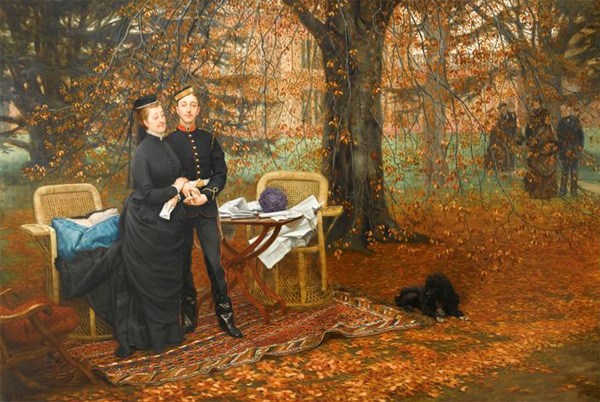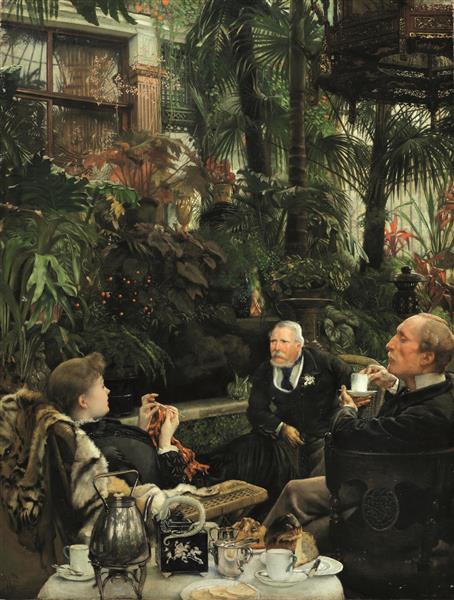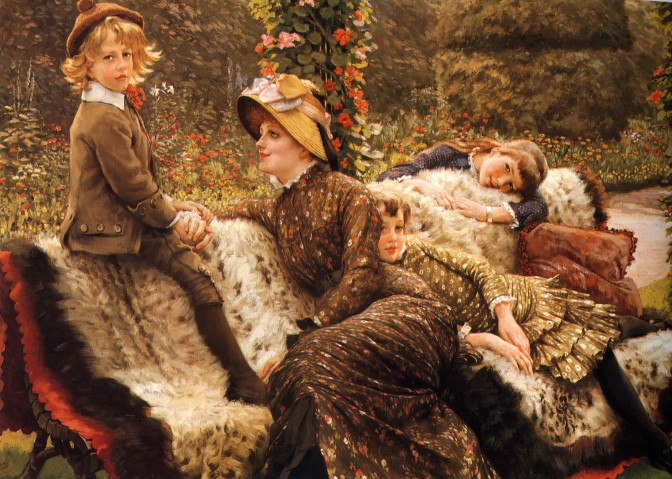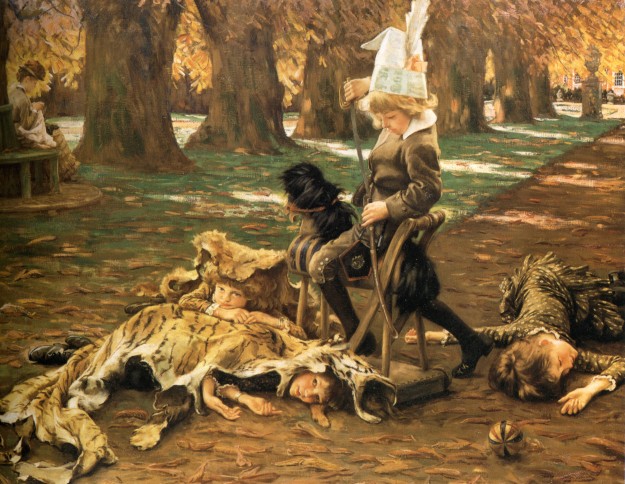To cite this article: Paquette, Lucy. “Wicker: James Tissot’s Modern Prop Furniture.” The Hammock. https://thehammocknovel.wordpress.com/2017/04/17/wicker-james-tissots-modern-prop-furniture/. <Date viewed.>
If you are a regular reader of my blog, you may recall this story:

Study for The Dreamer (or, Summer Evening, c. 1876), by James Tissot. Private Collection. (Photo: Wikiart.org)
James Tissot painted Kathleen Newton in the study above [called The Dreamer] about 1876, selling it for £206 as Rêverie at the Dudley Gallery in London. In the 1920s, a man bought it “for a few pounds.” In 1984, the man’s daughter brought the picture to a valuation day at Woodbridge Community Hall in Suffolk, England. She had no idea what it was, but said, “It has been on the wall for as long as I can remember. My dad always used to poke around the sale rooms and this just came home. I can’t remember when. The story always was that he bought it because it reminded him of my mother, they both had the same auburn colored hair. Nobody knew anything about it in the family. We had it re-framed, and while it was at the framer’s somebody offered us £600 for it and so we thought we should get it looked at professionally.” A Sotheby’s representative at the valuation day said, “I remember turning round to say something to my secretary and when I turned back again this gentleman had put the picture down on the table in front of me. I remember taking one look at it and thinking to myself, “My God, a Tissot.”
What I haven’t mentioned is the way the Sotheby’s representative, Mark Armstrong, recognized the painting as a work by French painter James Tissot. Can you guess? No, it was not the familiar face of Tissot’s mistress and muse, the young divorcée Kathleen Newton (1854–1882). Mr. Armstrong asked the gentleman who owned the painting if he realized what it was, and when the man shook his head, he explained, “Certain things are always recognizable in these pictures, like the wicker chair for instance. Then when I saw [Tissot’s] signature and monogram, I honestly just could not believe it. It’s the kind of thing that makes these days come alive.”
Wicker, or woven, furniture was a new consumer good by James Tissot’s adult years.
Although wicker furniture first arrived in America on the Mayflower, production of wicker furniture in the United States began in the 1840s, after the Chinese opened a number of treaty ports to foreign trade. Clipper ships from China brought cargo to America with raw cane rattan used as dunnage to secure it and prevent shifting. This raw cane would then be discarded at the docks. In 1844, an enterprising young grocer, Cyrus Wakefield (1811 – 1873), pondered uses for the large quantities of abandoned rattan at Constitution Wharf in Boston. He realized how flexible the cane was, and after bending the rattan to produce a chair, he saw the potential of the material.
Wakefield soon began to import his own clipper ships full of rattan, which was in great demand by basket and furniture makers. By 1851, he started making furniture from woven rattan, and it became popular.
In 1855, Wakefield and his wife left Boston and moved to South Reading [renamed Wakefield in 1868], Massachusetts, where he established the Wakefield Rattan Company. He continued to sell the imported rattan throughout the United States and to experiment with techniques to construct wicker furniture. Bending oak or hickory into frames wrapped with split cane, the flowing shapes were filled with ornate rattan patterns.
Previously, the inner core, or the reed, of the rattan plant had been discarded, but Cyrus Wakefield and others began experimenting with the use of reed. In 1856, civil unrest in China resulted in a cutoff of the rattan supply, which led to more experimentation using the reed; it was discovered that reed but was porous and could be painted or stained.
The Wakefield Rattan Company expanded during the 1860s and virtually cornered the market on hand-woven furniture. But toward the end of the decade, a loom was created that sped production of the furniture by automatically weaving and installing the chair seats.
In the early 1870’s, products manufactured by the Wakefield Rattan Company included “chairs for ladies, gentlemen and children, cradle, cribs, tete-a-tete and sofas,” as well as matting, baskets, baby carriages, window shades, brooms, clothes beaters, hoops for ladies’ skirts, and many other items. [Click here to see an advertisement c. 1872.]
Tissot moved to London in mid-1871, in the aftermath of the Franco-Prussian War and the Bloody Paris Commune. In 1873, he bought the lease on a medium-sized, two-storey Queen Anne-style villa, built of red brick with white Portland stone dressing, at 17 (now 44), Grove End Road, in the leafy suburb of St. John’s Wood. The house was set in a large and private garden separating him from the horse traffic, omnibuses and pedestrians on their way to the Regent’s Park or the still-new Underground Railway station nearby.
In 1873, Tissot featured the same curvaceous bentwood rocking chair with a woven-cane seat and back in two of his paintings, A Visit to the Yacht and The Last Evening.

A Visit to the Yacht (c. 1873), by James Tissot. Oil on canvas, 34 by 21 in. (87.6 by 56 cm). Private Collection. (Photo: Wikimedia.org)

The Last Evening (1873), by James Tissot. Oil on canvas, 28.3 by 40.6 in. (72 by 103 cm). The Guildhall Art Gallery, London. (Photo: Wikimedia.org)

The Empress Eugénie and the Prince Impérial in the Grounds at Camden Place, Chislehurst (c. 1874), by James Tissot. Oil on canvas, 50 by 60 in. (106.6 by 152.4 cm). Musee Nationale du Chateau de Compiegne, France. (Photo: Wikimedia.org)
About 1874, in the face of rumors that Tissot was a Communard, he painted a dual portrait of the exiled French empress and her son, which seemingly refutes the charge. In The Empress Eugénie and the Prince Impérial in the Grounds at Camden Place, Chislehurst, Tissot depicts the exiled royals risen from lightweight wicker readings chairs. In the autumnal scene, the portable chairs strike an ephemeral note.
In 1875, Tissot built an extension with a studio and huge conservatory that doubled the size of his house.

In the Conservatory (The Rivals, c. 1875), by James Tissot. Oil on canvas, 15 1/8 by 20 1/8 in. (38.4 by 51.1 cm). Private Collection. (Photo: Wikipaintings.org)
In In the Conservatory (The Rivals, c. 1875), Tissot features the back of a substantial, circular roll-back wicker armchair, with its elegant herringbone pattern shown in full detail.
The Wakefield Rattan Company participated in the 1876 Centennial Exhibition in Philadelphia, which was attended by nearly a quarter of the population of the United States. Since middle-class American families were just beginning to move to suburban and country homes, there was a demand for informal furniture for porches, summer homes and even parlors. [Click here to read more on the Wakefield Rattan Company.]
From the 1870s through the late 1890s, the Wakefield Rattan Company faced fierce competition from another furniture maker, Heywood Brothers Company of Gardner, Massachusetts. Both companies offered increasingly original and elaborate designs with outstanding craftsmanship, and wicker furniture, which was sturdy, lightweight, and elegant, became increasingly popular.
Wicker furniture also became fashionable in Victorian England, in part because it was considered sanitary. Unlike upholstered furniture, wicker was easy to clean and did not collect dust.
Tissot designed his garden with a blend of English-style flower beds as well as plantings familiar to him from French parks. He added an ornamental pond and a cast iron colonnade, copied from the Parc Monceau in Paris, which ran in a curve from the south side of the pool towards the house. A similar curved colonnade ran from the east end of the pool.
The bay window of Tissot’s new studio overlooked this idyllic landscape, which he enjoyed and painted repeatedly.

The Convalescent (c. 1876), by James Tissot. Oil on canvas; 30.2 by 39.06 in. (76.7 by 99.2 cm). Museums Sheffield. Courtesy of The Bridgeman Art Library for use in “The Hammock: A novel based on the true story of French painter James Tissot” by Lucy Paquette © 2012.
In Tissot’s The Convalescent (c. 1876), two women model in a grouping of three comfortable wicker armchairs by his garden pool; the third chair is reserved slyly with a man’s hat and cane.
The convalescing woman’s chair, with its squared back, round base, flat armrests and vertical supports, is so similar to the chairs in The Empress Eugénie and the Prince Impérial that they either were purchased from the same source, or possibly owned by Tissot and transported to Chislehurst for the portrait setting.

Holyday (c. 1876), by James Tissot. Oil on canvas. Tate Britain, London. (Photo: Wikimedia.org)
In Holyday (c. 1876), the elderly chaperone minds her own business in a wicker chair to the left while a youthful group picnics at the side of Tissot’s garden pool.

The Letter (c. 1878), by James Tissot. 27 by 40 in. (68.58 by 101.60 cm). National Gallery of Canada, Ottawa, Ontario. (Photo: Wikimedia.org)
A lightweight wicker dining set is shown in the back of this garden in The Letter (c. 1878), said to be set in the Dutch Gardens of Holland House in London.
Here’s the interesting thing – or one of them, anyway: Tissot’s career spanned forty-three years, from 1859, when the 23-year-old launched his career in Paris, competing with established artists by exhibiting five entries in the Salon, until his death in 1902, while he still was working on an illustrated Old Testament (published in 1904). Yet the wicker chair(s) so associated with his work appeared only in his paintings during nine of the years within his London period, 1871 to 1882, which overlaps the six years, 1876 to 1882, when Kathleen Newton lived with him in his elegant St. John’s Wood villa in London.
In those nine years, Tissot painted fewer than two dozen pictures that include a wicker armchair, chaise, or stool.

Kathleen Newton in an Armchair (1878), by James Tissot. Oil on panel, 12 by 17 in. (30.5 by 43.2 cm). Private Collection. (Photo: Wikimedia.org)
In Kathleen Newton in an Armchair (1878), Tissot features a wicker reading chair in the corner of his studio, overlooking his garden. With its flat armrests, this chair is similar in design to the chairs in The Empress Eugénie and the Prince Impérial in the Grounds at Camden Place, Chislehurst (c. 1874) and The Convalescent (c. 1876), but this chair has a slightly arched back, unlike the squared back of the other chairs.

Rivals (1878 – 1879), by James Tissot. Oil on canvas, 36.22 by 26.77 in. (92 by 68 cm). Musée d’Orsay.
In Rivals (1878-1879), Tissot’s wicker reading chair has been moved to the conservatory so Mrs. Newton may lounge while modeling. The older gentleman sits in a wicker chair as well.
The wicker pieces offered an interesting textural contrast within Tissot’s compositions.

Hide and Seek (1877), by James Tissot. National Gallery of Art, Washington, D.C. Courtesy of The Bridgeman Art Library for use in “The Hammock: A novel based on the true story of French painter James Tissot” by Lucy Paquette © 2012
In Hide and Seek (1877), Kathleen Newton reads the paper while lounging in the wicker reading chair in the corner of his elegant studio, where French doors open into the garden.

La sœur aînée (The Elder Sister), c. 1881, by James Tissot. Oil on panel, 17.5 by 8 in. (44.45 by 20.32 cm). Private Collection. (Photo: http://www.the-athenaeum.org/)
The lacy, lightweight wicker chair in La sœur aînée (The Elder Sister, c. 1881), easily could be moved in and out of the house.
James Tissot, one of the first artists to use photography as the basis for his oil paintings, and who kept a photographic record of all his works, was a thoroughly modern man. The wicker furniture that he owned and portrayed in his paintings is, like his depiction of current female and male fashions, one more sign of his contemporary style.

Kathleen Newton at the Piano (c. 1881), by James Tissot. Private Collection. (Photo: Wikiart.org)
In this oil study, Kathleen Newton at the Piano (c. 1881), she is seated on a wicker stool covered in a heavy cloth.
When Kathleen Newton died of tuberculosis on November 9, 1882, at age 28, Tissot returned to Paris after the funeral the following week. Within a year, he sold his London villa to the Dutch-born painter Lawrence Alma-Tadema (1836 – 1912).
Never again did James Tissot’s paintings feature the graceful wicker furniture of his leisured life in London.
Related posts:
For sale: In the Conservatory (Rivals), c. 1875, by James Tissot
James Tissot’s house at St. John’s Wood, London
James Tissot’s garden idyll & Kathleen Newton’s death
© 2017 by Lucy Paquette. All rights reserved.
The articles published on this blog are copyrighted by Lucy Paquette. An article or any portion of it may not be reproduced in any medium or transmitted in any form, electronic or mechanical, without the author’s permission. You are welcome to cite or quote from an article provided you give full acknowledgement to the author.
 If you do not have a Kindle e-reader, you may download free Kindle reading apps for PCs, Smartphones, tablets, and the Kindle Cloud Reader to read The Hammock: A novel based on the true story of French painter James Tissot. Read reviews.
If you do not have a Kindle e-reader, you may download free Kindle reading apps for PCs, Smartphones, tablets, and the Kindle Cloud Reader to read The Hammock: A novel based on the true story of French painter James Tissot. Read reviews.
The Hammock: A novel based on the true story of French painter James Tissot, brings Tissot’s world from 1870 to 1879 alive in a story of war, art, Society glamour, love, scandal, and tragedy.
Illustrated with 17 stunning, high-resolution fine art images in full color
Courtesy of The Bridgeman Art Library
(295 pages; ISBN (ePub): 978-0-615-68267-9). See http://www.amazon.com/dp/B009P5RYVE.

















 If you do not have a Kindle e-reader, you may download
If you do not have a Kindle e-reader, you may download